Journal
of Non-lethal Combatives, Dec 2000
The Secrets of Jujitsu, A Complete Course in Self
Defense, Book V

By Captain Allan Corstorphin Smith, U.S.A.
Winner of the Black Belt, Japan, 1916. Instructor of Hand-to-Hand Fighting,
THE INFANTRY SCHOOL, Camp Benning, Columbus, Georgia and at United States
Training Camps and Cantonments, 1917 and 1918.
In Seven Books.
BOOK FIVE
STAHARA PUBLISHING COMPANY
Columbus, Georgia, 1920.

***
This electronic version is copyright EJMAS © 2000. All rights
reserved.
Contributed by Thomas J. Militello, a 15-year member of Astoria,
New York's non-profit Horangi Taekwondo Dojang, which is headed by James
Robison.
Readers interested in seeing film images should note the following
film held by the National Archives and Record Administration:
NWDNM(m)-111-H-1180.
Title: Physical and Bayonet Training, 1918.
Scope and Content: Recruits at Camp Gordon, Georgia receive detailed
instruction in boxing and jiu-jitsu. Wrestling and jiu-jitsu holds are
used against a foe with a bayonet. Troops do calisthenics and play rough
games calculated to make them physically fit.
35mm film, 15 minutes
Judging from responses from the US Army historians at Forts Myer
and Benning, little biographical information is available concerning Captain
Smith. Therefore readers with additional information are requested to contact
the editor at jrsvinth@juno.com.
LESSON 19
This lesson teaches you: --
-
First defense against downward blow of knife. (The elbow break.)
-
The counter to the elbow break.)
| |
Name of Partner |
Date Commenced |
Elbow Break |
Counter |
| 1. |
|
|
|
|
| 2. |
|
|
|
|
| 3. |
|
|
|
|
| 4. |
|
|
|
|
| 5. |
|
|
|
|
| 6. |
|
|
|
|
| 7. |
|
|
|
|
| 8. |
|
|
|
|
| 9. |
|
|
|
|
| 10. |
|
|
|
|
Make a check mark against each trick each day you practice it.
FIRST DEFENSE AGAINST DOWNWARD BLOW OF KNIFE (THE
ELBOW BREAK)
Assailant steps forward with his right foot bringing down his right
arm as if aiming a blow with a knife.
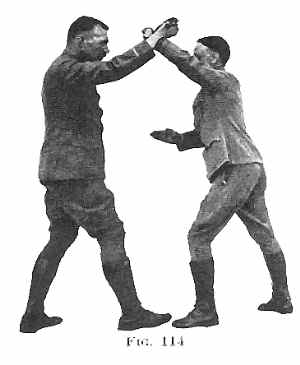
Step in with your left foot lowering your body slightly, and keep it
perfectly erect.
Stop Assailant's right forearm with your left forearm.
Pass your right forearm under Assailant's upper arm, pulling his upper
arm toward you and forcing his forearm back with your left forearm.
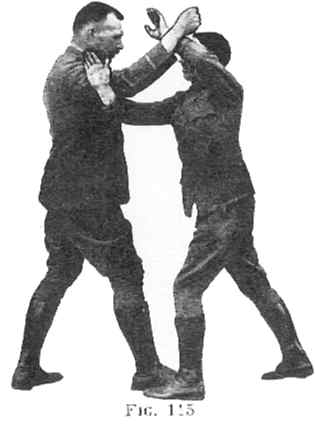
This is a much quicker and surer method of taking the elbow break than
grasping his forearm with your hand.
Continue forcing his forearm back until your right hand comes onto the
back of your left hand. This will unbalance him backwards.
To show position more clearly, my left hand is open in photo. Naturally
it would be closed.
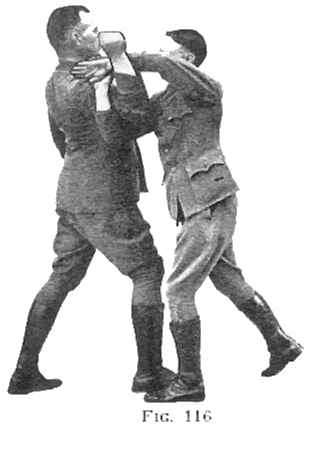
It is easy to break an arm, so although you perform the major operation
quickly, do the minor operation slowly and gently.
Force his right hand back until he gives the signal of defeat.
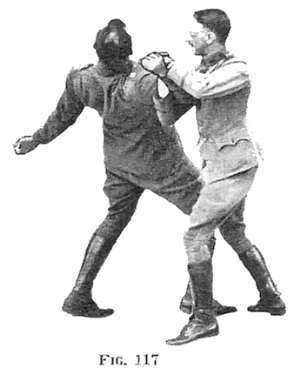
The most important point is to unbalance Assailant and retain your own
balance.
Allow one another to try this lock on the unresisting arm, repeatedly,
slowly and carefully.
Continued practice will enable you to secure this grip like a flash.
DO NOT BECOME UNBALANCED
COUNTER TO ELBOW BREAK
In trying to get the elbow break the man on the right has stepped in
and lost his balance.
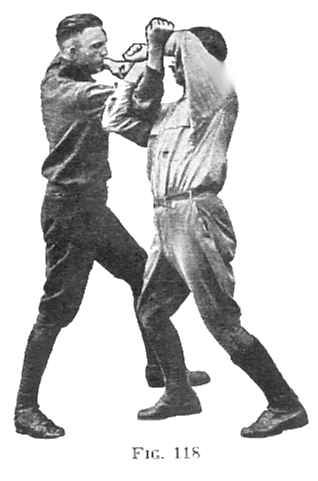
He has thrown his elbow around opponent's upper arm instead of pulling
it towards him. He has left opponent on balance, and he himself
is off balance.
Opponent therefore has only to shove him backwards to cause him to fall
to the ground.
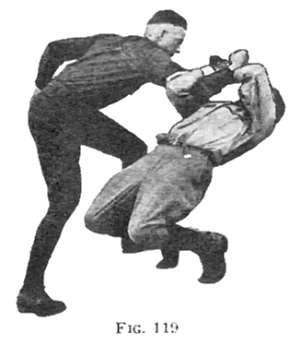
Opponent is in a position, if he wishes, to throw him hard enough to
knock him out.
By practicing this a few times you will learn not to become unbalanced
while trying jujitsu tricks.
LESSON 20
This lesson teaches you: --
-
Escape from the elbow break.
-
Prevention of escape.
-
Wrong method of elbow break.
| |
Name of Partner |
Date Commenced |
Escape |
Prevention |
Wrong |
| 1. |
|
|
|
|
|
| 2. |
|
|
|
|
|
| 3. |
|
|
|
|
|
| 4. |
|
|
|
|
|
| 5. |
|
|
|
|
|
| 6. |
|
|
|
|
|
| 7. |
|
|
|
|
|
| 8. |
|
|
|
|
|
| 9. |
|
|
|
|
|
| 10. |
|
|
|
|
|
Make a check mark against each trick each day you practice it.
ESCAPE FROM ELBOW BREAK
As Assailant slowly presses you down with the elbow break, slowly twist
your body to the left, thus releasing your elbow and lowering your right
hand..
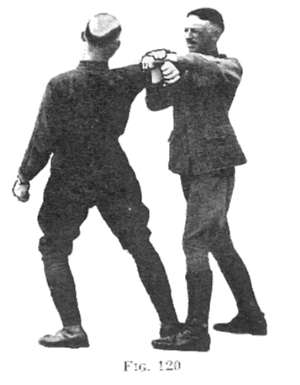
It will then be easy for you to twist around, release your right hand,
and give your opponent the elbow blow in the solar plexus with your left
arm.
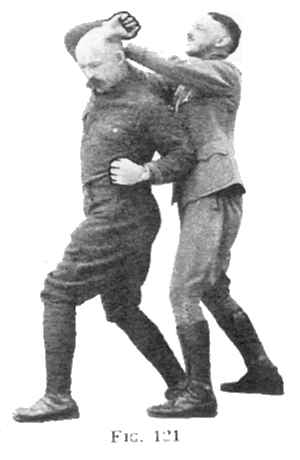
(The instructions are so worded that the veriest tyro will have no difficulty
in doing the trick correctly and without danger.)
PREVENTION OF ESCAPE
Frustrate opponent's efforts to escape by pressing with your left forearm
and pulling with your right forearm.
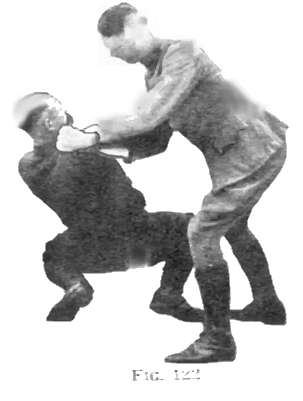
A little experimenting will show just how it is done.
In this practice, be cautious. Go slow.
By continuing the pressure on his elbow it is easy to force him to the
ground. It is superfluous to trip him.
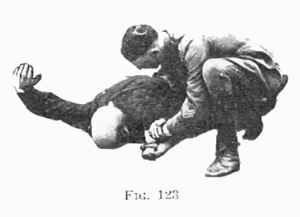
In case of necessity it is easy to break his arm or to hold him prisoner.
WRONG ELBOW LOCK
Some instructors teach you to block your Assailant's arm with your own
right forearm.
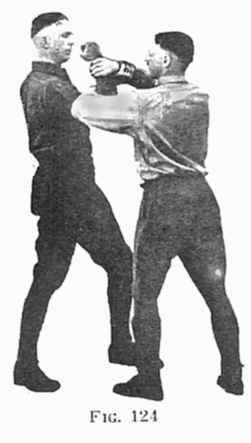
Pass your left hand behind his forearm and grasp your right wrist.
Force his hand back until he quits.
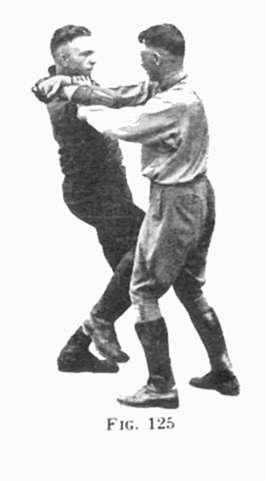
THE COUNTER
The counter to this trick is obvious and easy.
Simply bend one knee, dropping down, thus relieving the pain in your
elbow.
Raise the other knee, and kick him in the stomach.
LESSON 21
This lesson teaches you: --
The second defense against downward blow of knife.
It also teaches you the principle of the line of support.
| |
Name of Partner |
Date Commenced |
Second Defense |
| 1. |
|
|
|
| 2. |
|
|
|
| 3. |
|
|
|
| 4. |
|
|
|
| 5. |
|
|
|
| 6. |
|
|
|
| 7. |
|
|
|
| 8. |
|
|
|
| 9. |
|
|
|
| 10. |
|
|
|
Make a check mark against each trick each day you practice it.
SECOND DEFENSE AGAINST DOWNWARD BLOW OF KNIFE
Assailant may frustrate your attempt to secure the elbow break by straightening
his arm.
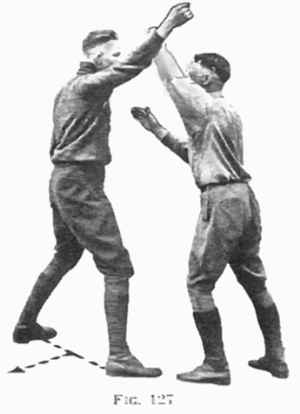
Immediately give up the idea of trying for the elbow break and instead,
force his arm straight up and back.
Catch him on the throat with the space between the thumb and forefinger,
of your right hand, pushing him back at right angles to his line of support.
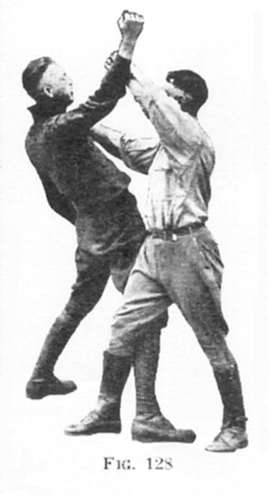
This shows a trip by bringing your right leg behind his right leg. This
can only be done when his right leg is forward.
It is superfluous, as if you strike him smartly on the neck, in the
proper direction, he will go down like a ninepin.
If you are ever up against a man with a knife, the most important thing
for you if you wish to survive, is to give him your knee, either before
or after your hand has reached his throat.
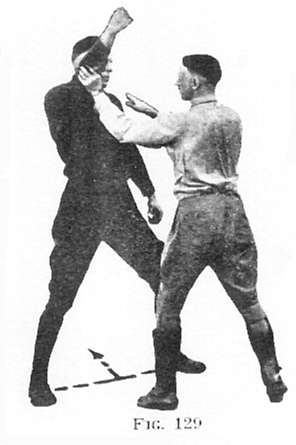
Assailant again attacks you with his right arm stiff and straight making
the elbow break impossible.
Again force his right arm up unbalancing him backwards.
He has stepped forward with his left foot this time making it impossible
to trip his right leg as on previous page.
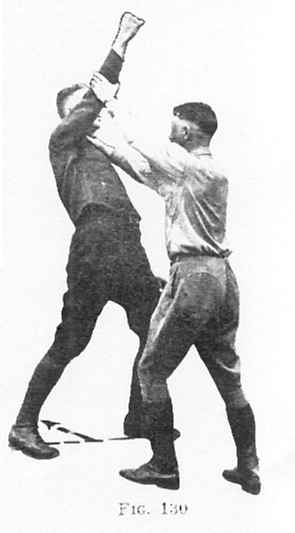
A trip is unnecessary as a blow to the throat with the right hand will
knock him over backwards.
The direction of the blow must be at right angles to his line of support.
This demonstrates that the trip shown on previous page is unnecessary.
You can throw your man in both cases much more quickly by the blow on the
throat.
In practice simply unbalance him slightly until you feel that
you could throw him with a little extra shove.
THE LINE OF SUPPORT
The line of support is a line drawn between your feet.
If the pressure you exert against opponent runs in the same direction
as his line of support you are working against his strongest point.
To illustrate, when opponent has right leg forward, if you push against
his left leg, you are working against his strongest point.
If his left leg is forward and you push against his right leg, you are
fighting 100% of his strength.
Instead of that, if you work at right angles to his line of support,
as illustrated in figures 128 and 130, you can always throw him, if you
work neatly.
If on the other hand you work clumsily and allow him to divine your
intention, he can change his line of support and bring it parallel to the
direction of your pressure, and thus frustrate your intentions.
This principle I submit as the solution of the enigma propounded in
the terse observation (credited alike to Bob Fitzsimmons, of cherished
memory, and the more humble disciples of the cult of jujitsu), "The bigger
they are, the harder they fall."
It also supplies the clue to the broader principles of jujitsu on which
the statesmen, financiers, and economists, both of the Orient and Occident,
base their diplomatic relations with each other.
No teacher at whose feet I have sat, or whose writings I have earnestly
studied, has ever informed me of this principle.
I have had to find it out for myself, and I therefore submit it, I hope
with pardonable pride, as my own discovery.
However, history relates that when Columbus showed a critical world
how to stand an egg on its end, he was told that he arrogated too much
credit to himself.
Similarly I may be told that my labored explanation is superfluous,
and that I have simply stated a well-known principle of applied mechanics.
If that is so, I shall not press my point, but instead shall express
pleasure and gratification that the principle is so thoroughly understood.
Will the kind reader retrace his steps to Book 4, and apply this principle
to his execution of the back throw.
He may then review all the other lessons in this course, and apply this
principle to every trick in which he should unbalance his opponent.
He may perhaps be generously inclined and admit that I have discovered
a new principle in the applied mechanics of hand-to-hand fighting.
If so, I thank him sincerely.
If not, I shall simply remark that it is a hard world, and pass on to
the next lesson.
LESSON 22
This lesson teaches you: --
The third defense against downward blow of knife.
It also teaches the comparative value of the three methods.
| |
Name of Partner |
Date Commenced |
Third Defense, Kick |
Third Defense, Blow |
| 1. |
|
|
|
|
| 2. |
|
|
|
|
| 3. |
|
|
|
|
| 4. |
|
|
|
|
| 5. |
|
|
|
|
| 6. |
|
|
|
|
| 7. |
|
|
|
|
| 8. |
|
|
|
|
| 9. |
|
|
|
|
| 10. |
|
|
|
|
Make a check mark against each trick each day you practice it.
THIRD DEFENSE AGAINST DOWNWARD BLOW OF KNIFE
The quickest method of turning the tables on a man who attacks you with
knife or pistol is to parry the blow with your forearm, stepping in and
lowering the body slightly, keeping erect and well-balanced.
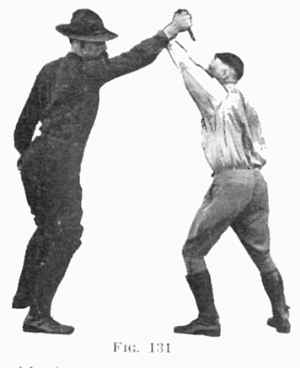
Kick him in the abdomen with the rear foot.
Bend your left knee slightly, this lowers your center of gravity and
gives you more balance.
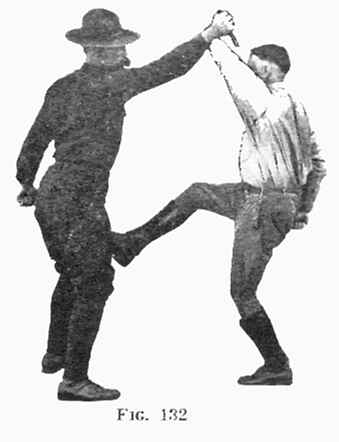
Make the effort from the Stahara, this makes the kick twice as powerful
as if you merely used the leg muscles. (See note further down re "The Jujitsu
Kick.")
This is a foul kick only to be used where Assailant is trying to kill
you. That is the only circumstance under which such a foul blow would be
justifiable.
A surer parry still is to block his blow above the elbow.
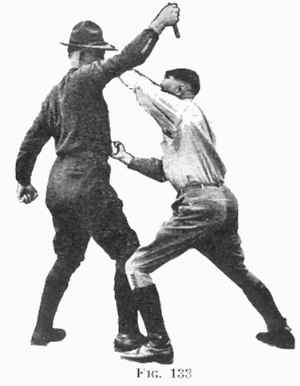
This necessitates stepping in closer and lowering your body more.
When you block his forearm, if he had a long knife it might reach your
head, but if you block his upper arm you are quite safe.
Simultaneously give him a sharp blow on the abdomen, either above or
below the belt.
This blow is made with a sharp jab, the return being as quick as the
blow.
In practice, put your full strength into the blow but stop it a few
inches from the target.
Whether you would use the kick or blow depends upon your distance from
the Assailant.
If you are farther away, the kick would be better, if you are closer
in, the punch would be quicker.
Although the knee kick to the crotch is not illustrated here, it is
the first thing to do in an emergency, as was taught to you in Book Two.
If you are a certain distance from Assailant you would use the toe kick,
Figure 132. In other positions you might use the punch, Figure 133. But
you would always precede or follow up with the knee kick.
Merely filing this information away in your mind is no good. This course
trains your subconscious by repeated practice of selected tricks to use
the best combination in an emergency.
THE COMPARATIVE VALUE OF THE VARIOUS DEFENSES
On account of the ease with which an Assailant's arm can be broken,
too high a value is apt to be placed on the elbow break. It is true that,
once secured, the elbow break wins the fight, and enables the smaller man
to take prisoner or disable his enemy.
There are many occasions where such a hold can be secured and it therefore
should be mastered.
But in an actual fight against a man armed with a knife the chances
of securing such a hold are only one in ten. The tactics taught in the
third defense against downward blow give you a much better chance for your
life.
Similarly the chances of securing the wrist twist taught in the first
defense against downward blow are only about one in ten against a man with
a knife.
The tactics taught in the second defense against upward blow are much
more effective and reliable. See remarks below, under first defense against
upward blow of knife.
In teaching men who were going to the war, all the training was directed
towards making them kick or hit a vital spot rather than try for a hold.
Mr. Haneishi, the jujitsu expert I brought from Japan with me, besides
being a professional teacher of the art is also a bone-setter, and general
first-aid practitioner.
He was once called in to render first aid to a burglar who had come
off second-best in an encounter with a householder. When Mr. Haneishi arrived
on the scene the burglar was dead, and blood was trickling from his mouth.
"Ah, you struck him on the mouth," observed Mr. Haneishi.
"No, I gave him suigetsu [solar plexus strike]," replied the
householder, who was over sixty, and from the use of this technical jujitsu
term the old man revealed himself as a graduate of the school of jujitsu.
It seems that the burglar threatened him by brandishing a two-handed,
razor-edged Japanese sword over his head, and demanded his money.
The old man advanced to give this, and the moment he was close up delivered
the blow shown in Figure 133 with deadly effect. The man collapsed, and
blood rushed from his mouth, showing that his internal organs were ruptured
by the blow, which is delivered with a penetrating effect and an upward
direction.
Lesson 23: First defense against upward blow of knife.
Lesson 24: Second defense against upward blow of knife.
Lesson 25: How to parry a blow, teaching unbalancing.
Lesson 26: How to sidestep a blow, teaching agility.
Lesson 27: Quickest way to throw a man after catching his foot.
Lesson 28: The inside catch: The backheel. Foot parry to kick.
Lesson 29: Going to the assistance of a friend.
Lesson 30: The elbow block.
| |
Name of Partner |
Date Commenced |
Lesson 23 |
Lesson 24 |
Lesson 25 |
Lesson 26 |
| 1. |
|
|
|
|
|
|
| 2. |
|
|
|
|
|
|
| 3. |
|
|
|
|
|
|
| 4. |
|
|
|
|
|
|
| 5. |
|
|
|
|
|
|
| 6. |
|
|
|
|
|
|
| 7. |
|
|
|
|
|
|
| 8. |
|
|
|
|
|
|
| 9. |
|
|
|
|
|
|
| 10. |
|
|
|
|
|
|
| |
Name of Partner |
Date Commenced |
Lesson 27 |
Lesson 28 |
Lesson 29 |
Lesson 30 |
| 1. |
|
|
|
|
|
|
| 2. |
|
|
|
|
|
|
| 3. |
|
|
|
|
|
|
| 4. |
|
|
|
|
|
|
| 5. |
|
|
|
|
|
|
| 6. |
|
|
|
|
|
|
| 7. |
|
|
|
|
|
|
| 8. |
|
|
|
|
|
|
| 9. |
|
|
|
|
|
|
| 10. |
|
|
|
|
|
|
Make a check mark against each lesson each day you practice it.
FIRST DEFENSE AGAINST UPWARD BLOW OF KNIFE
Block his blow with your left hand, taking care that your forearm is
held correctly, otherwise you may get cut.
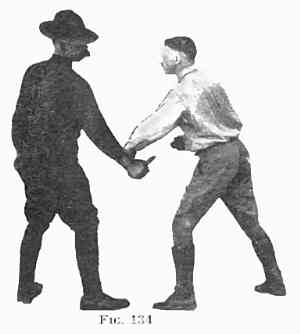
Seize the little finger side of his right hand with your right hand,
and the thumb side of his hand with your other hand, your fingers on the
palm.
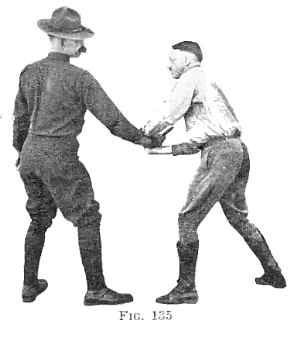
(Before doing this trick practice the preliminary exercise for the wrist
twist in Book 1.)
Twist his wrist to your left until he drops the knife.
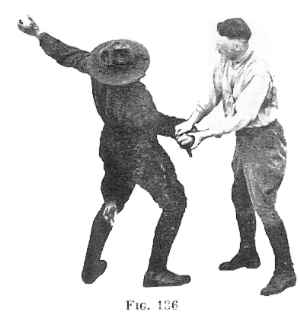
You can either break his wrist or force him to the ground and kick him.
(Observe my positions in Figures 135 and 136, and note how the strength
of the whole body is brought to bear.)
His wrist is twisted not by arm strength alone, but by turning the body.
The parry shown in Figure 134 is not nearly so good as the parry shown
in Figure 138.
In Figure 134 the Assailant is still balanced and can continue to attack.
In Figure 138 you can swing him off balance and he is then open to the
knee kick to his crotch, a right hook to his jaw with your fist, or a blow
with the heel of the hand below his chin.
A combination of the last three blows is much more reliable than an
attempt to seize the hand of a quick knife-artist.
SECOND DEFENSE AGAINST UPWARD BLOW OF KNIFE
Assailant strikes an upward blow at your abdomen with the knife in his
right hand.
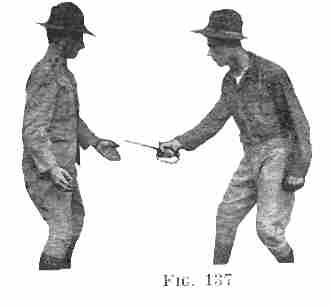
Step back with your right foot, swinging on the ball of the left.
Parry the blow just at his elbow with your left hand. Keep your elbow
close to your side.
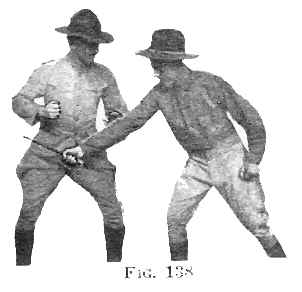
Take advantage of his forward impetus and unbalance him to his left.
Strike him an upward blow below the chin with the heel of your hand.
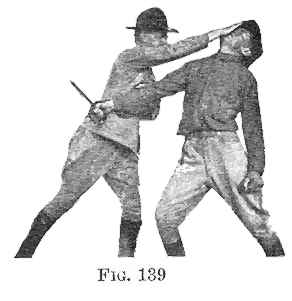
This jerks his head back and the shock to his spine does greater damage
than the blow itself.
Some women's wrists and hands are so weak that they cannot strike a
serious blow with the fist. But they can with the heel of the hand.
If you are a good boxer you may use the right hook to the jaw.
(In practice, shove his head back, do not strike.)
This shows the WRONG WAY to parry the blow.
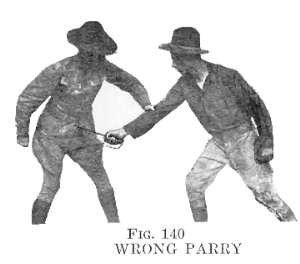
-
It takes longer to parry when you raise your elbow in this awkward fashion.
-
You are off balance and not in the best position to counter attack.
-
Your body is still in front and he may reach it with his knife.
HOW TO PARRY A BLOW
Suppose you try to frustrate an attack by parrying Assailant's left
forearm with your right hand.
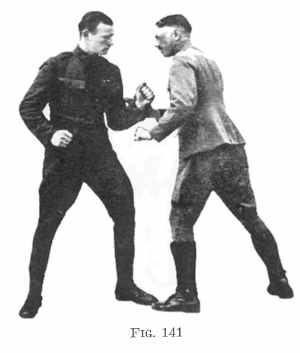
You deflect the blow of his left arm, certainly, but you leave him in
a position to use his right.
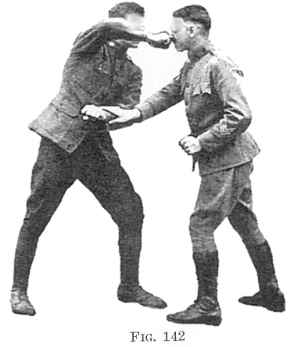
Make your parry at the elbow and you will turn his whole body
round and get him off balance, leaving an opening for a right hook
to the jaw or whatever method of attack you may choose.
Take the position of each of these illustrations and go through the
motions of parrying numerous blows.
This exercise is not to give you quickness in parrying, but, having
parried, it teaches you the correct angle at which to unbalance your Assailant.
Quickness is cultivated in the next lesson.
THE SIDESTEP
Starting with the right foot behind him, Assailant lunges forward and
makes a straight thrust at your abdomen.
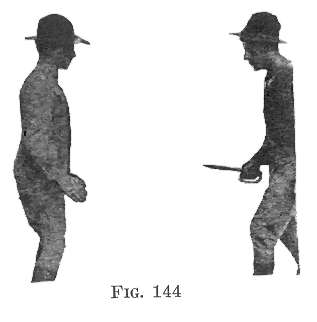
Swing back the right foot, turning on the ball of the left, keeping
your body perfectly erect and let the blow go past.
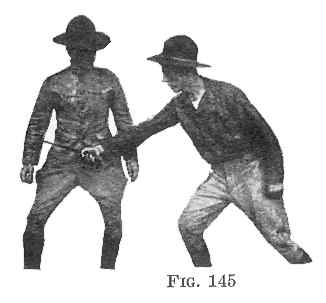
NOTES ON PRACTICE OF SIDESTEP
Practice the sidestep frequently, it is one of the best exercises for
training you to quickness of eye and agility of movement.
I have never seen anyone but a jujitsu man make a movement exactly like
this or the jujitsu kick, and it took years of observation and practice
to discover just what they were doing, and how they did it.
With the illustrations and instructions given here, there is no reason
why the reader should not master it right away.
Compare illustrations 144 and 145. The body swings round on the ball
of the left foot, just like a door, the effort, the motive power, comes
from the Stahara.
In Figure 145 the weight is evenly balanced between the legs, the knees
are slightly bent, the body limber.
Have Assailant lunge at you with left hand also, swing back the left
foot, turning on the ball of the right.
SIDESTEPPING THE KICK
Devote a good deal of time to this practice, both with right and left
feet. See Figures 146 and 147.
My Assailant in Figure 146 is kicking with the jujitsu kick with the
knee bent. This is such a swift kick that it is almost impossible to catch
it. Do not let this fact worry you as you can learn to sidestep a great
deal faster than the ordinary person can kick.
In practice, at first, Assailant should kick with the knee straight.
THE JUJITSU KICK
The jujitsu kick is given by raising the knee simultaneously with the
toe flying out. The foot travels at a terrific speed, and the recovery
is equally rapid, the foot being at once returned to the ground, or the
kick repeated.
The great secret about the jujitsu kick both with regard to the speed
and also the force of the blow is that the whole weight of the body goes
into it. In practice "Put your Stahara" into it, and you will soon get
it.
This kick is used only in emergencies of life or death.
QUICKEST WAY TO THROW A MAN AFTER CATCHING HIS LEG
When Assailant kicks at you, you should have sensed his intention almost
before his foot has left the ground.
Suppose he kicks with his left foot.
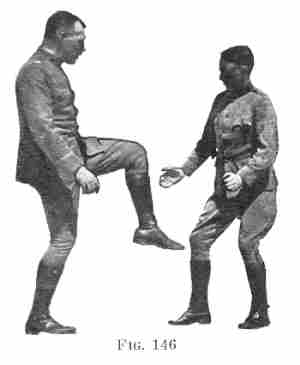
You swing back your left foot, turning on the ball of your right so
that you sidestep his kick.
At the same time catch his leg with your right hand.
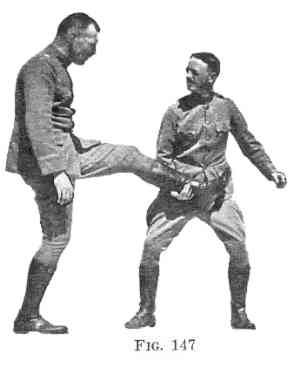
Do not stop his leg when you catch it, but swing it up in the direction
in which he is kicking.
This will at once put him right off balance.
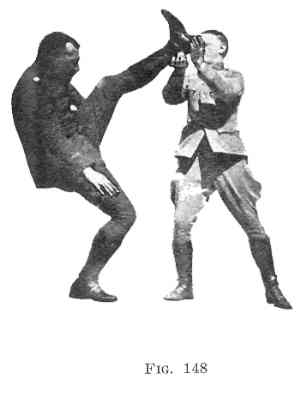
Swing it right up and shove it back a little and he will fall back hard
enough to be knocked out.
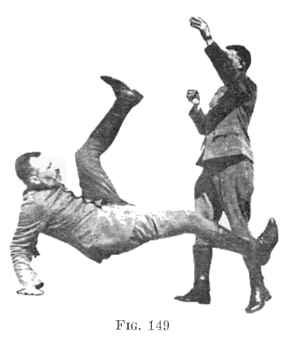
When you practice this have a third party ready to catch the man who
is thrown, otherwise your studies will probably be discontinued through
sudden cessation of interest by the party of the second part.
You can practice it without throwing him.
The whole trick is done with one swift movement.
THE INSIDE CATCH
Sometimes you may catch a man's leg inside, instead of outside. That
is, you might sidestep to the left and catch his left foot with your left
hand.
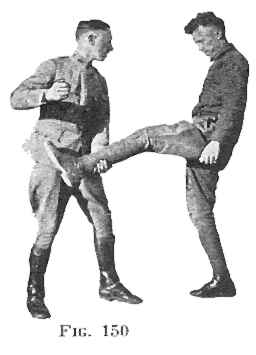
That is not so scientific as the outside catch, as it leaves you more
open to an attack from his hands.
The best method of throwing him here is the same as in the outside catch.
Raise his leg right up and throw him over backwards.
THE BACKHEEL
Here is another method. Change his leg over to your right hand. Bring
your left hand onto his shoulder (in a fight, onto his throat), unbalancing
him backwards, stepping inside his right heel with your left foot.
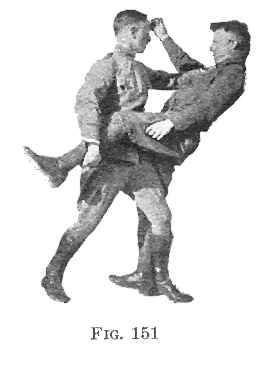
In practice it is unnecessary to throw him.
Just get him off balance to the point where you know you could
throw him.
Retain your own balance by keeping your strength in the Stahara.
UNSCIENTIFIC METHOD
Your arm is round his waist and you are throwing him by strength. It
is much slower, and he can hold on to you and perhaps prevent your throwing
him
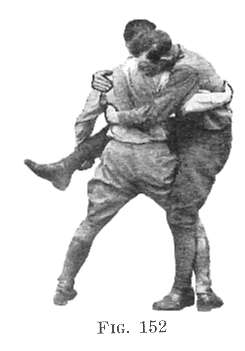
In Figure 151, by placing your hand on his shoulder you instantly unbalance
him and take away his strength.
Practice this with both feet for the experience it will give you in
personal contact.
FOOT PARRY TO KICK
If a man tries to kick you, say with the left foot, one of the quickest
ways to counter it is to swing round on the ball of your left foot, raising
your right leg, and catching him on the shin bone with the edge of your
shoe.
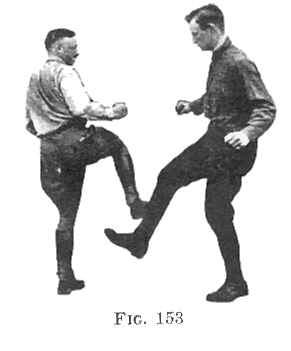
Drive your shoe down on his shin and you will incapacitate him temporarily
and thus leave him an easy victim to your next aggressive move.
Practice it without actually kicking, slowly at first. Later work up
to speed.
HOW TO RESCUE A FRIEND WHO IS HELD UP
ONE:
Steal up quickly behind the man who is pointing the pistol.
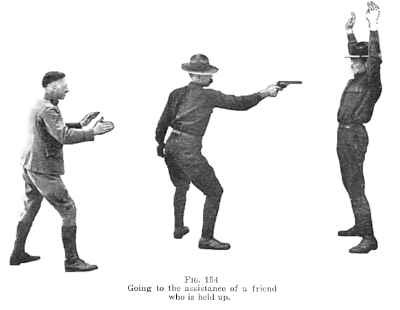
TWO:
Lay your left hand on his upper arm, just behind the elbow, and your
right hand on his wrist.
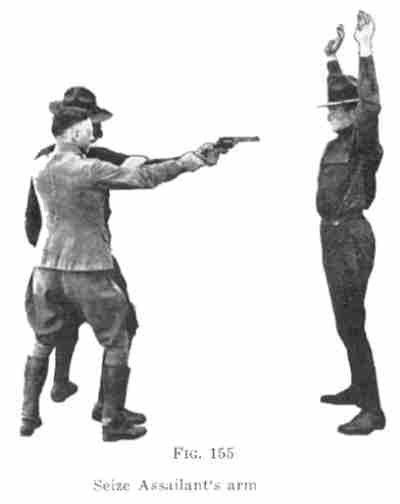
THREE:
Shove his elbow forward and jerk his forearm back, snapping his elbow,
and the pistol will fall from his nerveless hand.
Swiftness is essential in knocking his forearm up, otherwise he will
fire as you take hold.
The success of this trick depends on proper coordination of your movements,
which you will acquire by a little practice.
In practice, do this so slowly that there is no danger of injuring your
opponent's elbow. He will stand still and let you experiment, and you must
allow him the same privilege.
You can easily twist away while he does it slowly, but if you do so
he will never learn the trick.
Done quickly, there is no escape, but you must avoid speed in your first
practices.
Experiment very slowly until you find the correct angle at which to
push his elbow forward, and pull his wrist back.
After it is mastered, you may try pulling him back to the ground with
this hold.
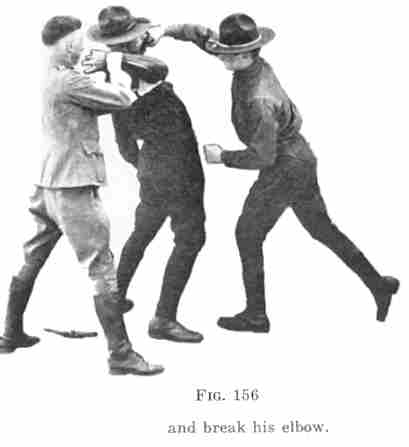
FOR USE AGAINST BURGLARS
The shock of breaking his elbow will be sufficient to knock the fight
out of any ordinary burglar, but there are some men who are so determined
and vigorous that they would still carry on the fight.
If you stooped down to pick up his pistol, he would kick you in the
face, and then he would recover his pistol with his left hand. Therefore
you must not merely break his arm, but throw him at the same time.
THE WRONG KIND OF JUJITSU
This is given as an example of the kind of jujitsu not to practice.
Seize his right wrist with your left hand. Place your right hand behind
his upper arm, above his elbow. Push with your left and pull with your
right and his arm will break.
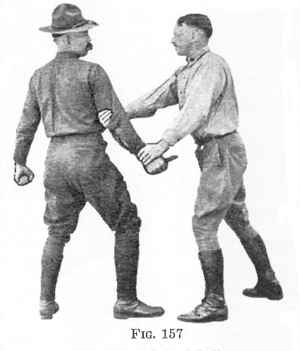
CRITICISM: This trick is no good because:
First: It is dangerous to practice on another's elbows. It is a "hit
or miss" trick. If ever you got it on an armed ruffian you would require
to break his arm immediately as you could not hold him and make him quit.
Second: If he bends his elbow before you get hold, you have not enough
leverage to break his arm.
Third: It is difficult to catch his wrist without being cut.
If you are ever taught a trick that is open to such criticisms you had
better discard it as not of much account.
THE ELBOW BLOW
Assailant aims a blow at your head with a straight swing.
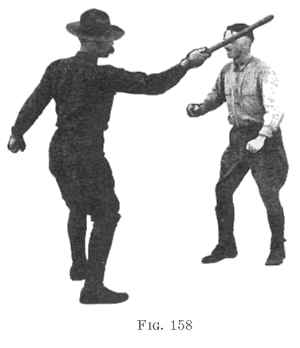
Step in with your right foot, lowering your body and ducking so that
the swing passes harmlessly over your head.
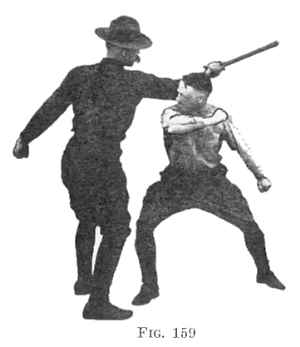
At the same time swing your right elbow into position shown in Figure
159.
Swing your elbow in the opposite direction, right into his ribs or midriff.
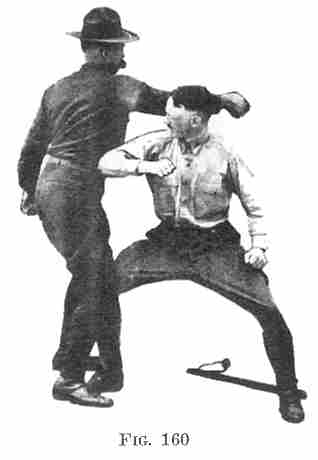
This is one of the most wicked blows known and will knock him out.
In practice, put all your force into the blow but stop it three or four
inches from Assailant's ribs.
Practice ducking, so that when you are in position of Figure 159 your
body is erect and balanced. At first you will probably be in too bent a
position, in which you cannot move quickly nor strike strongly.
As Assailant knows you are going to duck every time, he will be tempted
to strike lower and catch you as you duck. He must not do so however.
The ruffian who makes such a blow would not know you were going to duck,
and you would "get him" before he could change his plans.
The straight swing is not the kind of blow a boxer would deliver, but
is often used by an uneducated and ignorant Assailant. A man with a club
might also attack you by such a swing, and against such an attack, this
is the best defense.
Let Assailant aim a blow at your temple with his open hand. It is unnecessary
to use a stick in practice.
This exercise will quicken the eye.
THROW YOUR HAT IN HIS EYES
Face to face with an armed man, try to throw your hat in his eyes and
spring in before he can see clearly.
If you have not your hat, use anything, your handkerchief, a plate,
a bottle or glass.
If a man comes at you with a knife, particularly if he assumes the boxing
attitude, the left foot and hand advanced and the knife held in the right
hand thrusting upwards, you are up against an ugly customer who knows how
to use his knife. If you have a pistol you had better shoot him before
he gets near you.
If you have no pistol do not rush him, but make a "strategic retreat,"
"spar for an opening." If you are in a room, keep the furniture between
you, never let him get you in a corner. Use a chair or something and threaten
his head with it, and if he gets too near, bring it down on his head.
Try above all things to throw something in his face, water or some stronger
beverage. If you are in the open pick up stones, mud, anything, and try
to get it in his eyes.
The above instructions will be so simple and obvious to some people
that their inclusion here may seem superfluous. All people however are
not equally gifted and there are some to whom this advice may be welcome.
Unless you discipline your mind by thinking along these lines in times
of safety, the moment of danger may find you unprepared.













































